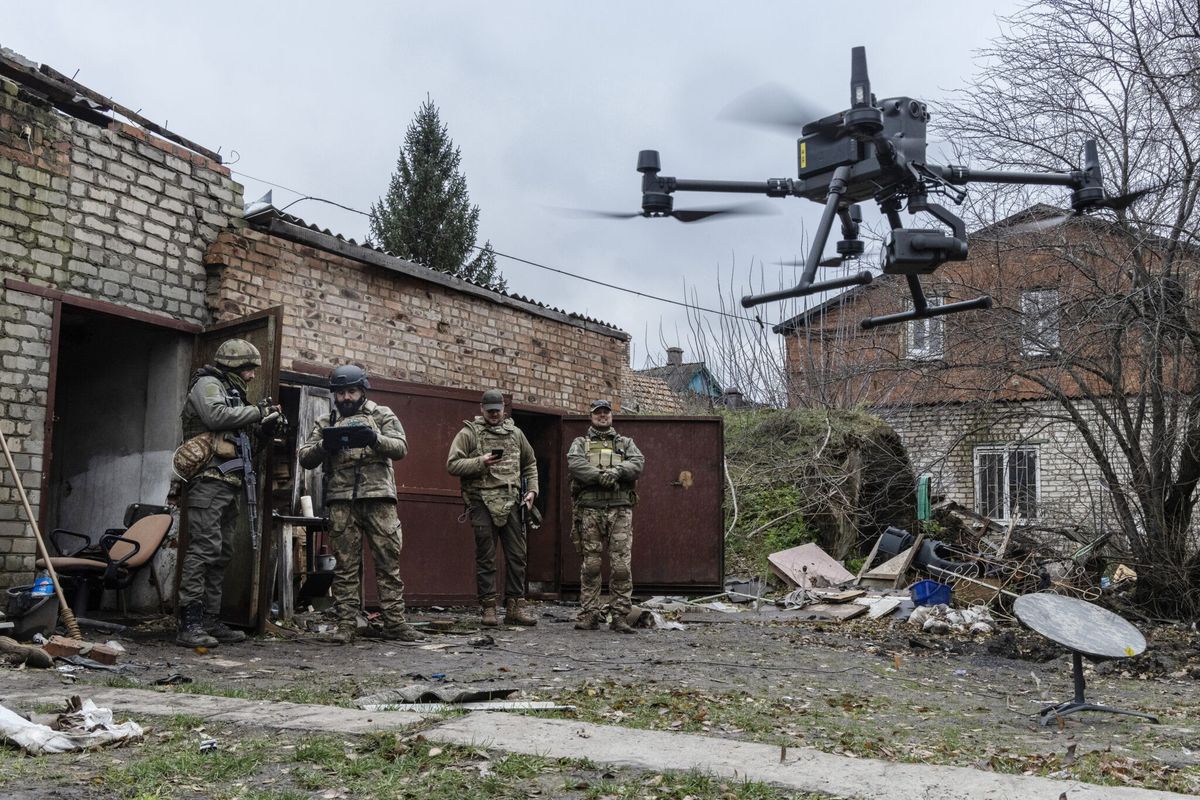SUBSCRIBER+ EXCLUSIVE REPORTING - As drones of all types – aerial, land, and maritime – grow in number and sophistication, so do nightmarish scenarios about their use. Drone weapons have already been used to deadly effect by both sides in Ukraine and by Iran’s various proxies in the Middle East, but what worries military and technological experts are the drone weapons of the future – a future that they believe is right around the corner.
Coming soon: AI-enabled drones that can pick out targets with no human direction; drones that might target U.S. infrastructure; and mass, synchronized movements of drones – so-called “drone swarms" –that might come after a military target. And experts say there is no reason to think that the U.S. and its allies will have anything close to a monopoly on these technologies.
The autonomous weapons expert Zachary Kallenborn shared a nightmare scenario that he said would be perfectly plausible in the near future.
“You send a whole bunch of drones equipped with facial recognition and search (Capitol Hill) for different congressmen who voted on a particular bill terrorists didn't like,” Kallenborn told The Cipher Brief. “They could narrow the search to target only those people and no one else – no staffers, civilians, anything like that. Only those particular congressmen. It could be quite scary, but also ideal from the terrorists’ perspective.”
Closer at hand, Kallenborn said, is the possible use of drones to disperse chemical or biological agents.
“Think about agricultural drones that are designed to release pesticides, which are more or less ready-made chemical biological weapons delivery systems,” he said. “They’ve got sprayers, valves, and vats that can hold hazardous chemicals and are designed to spray this type of material … I think that's a very real concern, especially as agricultural drones are commercially available, and there's currently no international regulations or restrictions on their transfer.”
These scenarios add to the existing deadly menace that drone weapons already represent in one conflict zone after another – Ukraine, Israel, Yemen, Syria, Sudan, and elsewhere.
Inevitably, the question becomes – how to defend against the threat? The Cipher Brief asked Kallenborn and other experts to explain how the U.S. and other countries are – or should be – preparing for the nightmares.
A matter of volume
The answer is immediately complicated by the vast array of drone weaponry already in use.
There’s the improvised commercial quadcopter used for close-in combat in Ukraine. There are the medium-range “suicide” drones – Iran’s Shahed, for example – that have pulverized military and civilian targets in Ukraine and throughout the Middle East. Then there are the high-end Unmanned Aerial Vehicles (UAVs) in the arsenals of the major powers – large, long-endurance platforms bristling with sensors and heavy munitions.
The current focus on a few global hot zones shouldn’t obscure the fact that weaponized drones are everywhere. Today, 113 nations have access to military drones; a decade ago, the figure was only 58. Beyond nation-states, it's estimated that 65 distinct non-state actors – insurgents, militias, drug cartels and other groups – have sophisticated drone weapons at their disposal.
Nearly every new offensive drone weapon requires a countermeasure. And in the brave new world of drones, countermeasures don’t involve troops or conventional weapons.
Several nations engaged in current conflicts – Ukraine, Russia, Israel, the U.S. and others – are already using counter-drone technologies, and rushing to develop enhancements. The challenge is keeping pace with the relentless innovations of drone makers. The Joint Counter-Unmanned Aircraft Systems Office at the Pentagon, along with a corresponding program in NATO, are currently tasked with nothing but the work of countering drones.
The countermeasures break into two broad categories – kinetic and non-kinetic.
Shaan Shaikh, deputy director of the Missile Defense Project at the Center for Strategic and International Studies (CSIS), described the options when it comes to mounting effective solutions. “The interceptor of choice might depend on target type, range, quantity, location, and the potential for collateral damage, among other factors,” Shaikh told The Cipher Brief. “If you want to shoot down a large drone with a high probability of kill, then a kinetic interceptor may be best. But if you’re shooting down small drones in large numbers, then you may prefer using lasers or high-powered microwaves to intercept them at lower cost per shot.”
In December, the U.S. State Department listed several kinetic counter-drone systems among the military gear it was sending to Ukraine – “Vampire” counter-Unmanned Aerial Systems (c-UAS), c-UAS gun trucks, and mobile c-UAS laser-guided rockets. The Vampire is a portable system that can be mounted on trucks. It fires advanced precision rockets equipped with fuses designed to detonate in the proximity of a drone.
Other NATO allies have provided non-kinetic counter-drone systems to Ukraine. Lithuania recently delivered “Skywiper” electronic drone mitigation systems, designed to interrupt radio frequency control and navigation operations, and thus send drones off their marks. Mobile signal jamming devices are widely used by both sides to counter drones, but these have inherent limitations; some systems require direct line-of-sight to the target, and unpredictable drone flight patterns can confuse tracking devices.
Further clouding the picture, drone designers are rapidly developing workarounds to simple jamming methods – equipping their platforms to operate autonomously, meaning no signal connection to a ground operator is necessary. Russia’s Orlan-10 drones are an example; they possess advanced autonomous features that have allowed Russian forces to evade Ukrainian countermeasures and get through to their targets. The Orlan drones were reportedly a key factor in frustrating last year’s Ukrainian counteroffensive.
As Shaikh put it, “this is a cat-and-mouse game. UAS technologies improve, c-UAS defenses catch up, and the cycle repeats. Technology developments are unlikely to give either side a long-term advantage.”
Waiting for a catastrophe
Worried as they are, some experts say they are baffled by the fact that terrorists have yet to employ armed drones in an attack against civilian targets outside a war zone.
Jamey Jacob, director of Oklahoma State University’s Aerospace Institute for Research and Education, noted that “the fact that we haven’t had any serious domestic incidents is a blessing, and really comes as a surprise due to the potential impact.”
But the experts assume it’s only a matter of time, and as NBC News reported last month, such fears have sent U.S. tech companies, working with the Department of Homeland Security (DHS), scrambling for ways to head off the all-too-real peril. Jacob told The Cipher Brief that roughly 100 firms are working on drone countermeasures, ranging from established defense contractors like Raytheon and Lockheed Martin to startups exploring a variety of spoofing and hacking devices to defeat drone systems.
One effort specifically aimed at what DHS calls the “nefarious” use of drones involves a partnership between the department and the tech sector and academia, including Oklahoma State University and the University of North Dakota. The initiative is looking at both kinetic and non-kinetic domains to develop prototypes and help evaluate different drone countermeasures.
Last week, DHS offered a preliminary assessment of two rounds of counter-drone field tests held last summer. The first involved kinetic means, or as DHS described it, “accelerating masses to physically alter, bring down, or destroy drones — forces such as projectiles, nets, photon plasma from lasers, and electromagnetic or radio waves.”
The second round of DHS tests covered non-kinetic defenses designed to detect, track, and foil small drone swarms operating under remote control. One facet of the field test involved detecting and countering “dark drones,” those that emit little or no radio frequency signals. The scenarios included an enemy using drone swarms to interfere with first responders responding to a serious emergency, and a swarm assault on critical infrastructure.
DHS noted that the results of the field tests are under review and will feed into additional assessments of counter-drone defenses to be done this summer. Still to be evaluated: the risks associated with the various counter-drone options, including the collateral damage that could result from putting them into operation.
Given the constant give-and-take between drone threat and counter-threat, the cat-and-mouse analogy persists – and for now, solutions appear elusive.
“You need a combination of different types of capabilities that are...specific to the context in which the defender is operating,” Kallenborn told The Cipher Brief. “There's no silver bullet and I'm skeptical that there will ever be a silver bullet.”
Read more expert-driven national security insights, perspective and analysis in The Cipher Brief












